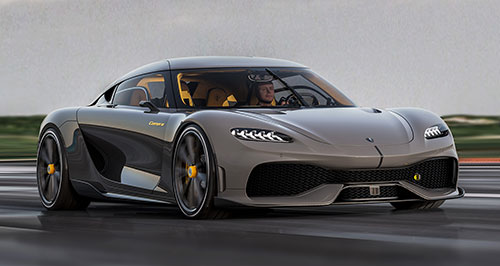Make / Model Search
Future models - Koenigsegg - GemeraKoenigsegg dreams up Gemera four-seat hypercarGemera plug-in hybrid ‘mega-GT’ is a kid-friendly Koenigsegg that can do 400km/h5 Mar 2020 KOENIGSEGG, renowned for pushing the automotive performance envelope with brain-bending engineering methods, has turned its attention to family transport with a remarkable mid-engined plug-in hybrid capable of transporting four people at 400km/h.
Named Gemera, the Swedish hypercar specialist’s four-seat foray measures its power output in megawatts – 1.27 of them – and develops 3500Nm of torque, sufficient to propel the vehicle from rest to 100km/h in 1.9 seconds.
Crucially, it has Isofix child seat anchorages in the back of what Koenigsegg describes as the “true four-seater” cabin of “the world’s first mega-GT”.
Unsurprisingly, the majority of the Gemera’s mammoth performance comes from a trio of electric motors. But this would not be a Koenigsegg without a serious engineering twist in the tale.
The beating heart is a dry-sumped 2.0-litre three-cylinder engine that develops 440kW and 600Nm, outputs McLaren extracted from a 3.8-litre twin-turbo V8 in its 12C supercar.
Until the Gemera came along, Mercedes-AMG produced the most powerful 2.0-litre engine with its 310kW/500Nm four-cylinder as used in the A45 S hyper hatch and CLA45/GLA45 derivatives.
With a pair of turbos using clever plumbing to enable two stages of boost and Koenigsegg’s ‘freevalve’ technology, the aptly named Tiny Friendly Giant (TFG) engine produces peak power at 7500rpm and maximum torque from 2000rpm to 7000rpm.
A chunky 400Nm is available from just 1700rpm and the redline is 8500rpm, yet the TFG weighs just 70kg and is claimed to be 15-20 per cent more fuel-efficient than a typical 2.0-litre turbo four.
It is also designed to run on alcohol-based biofuels, which Koenigsegg claims can make running the Gemera carbon neutral or even carbon positive depending on the fuel and electricity sources used, but the TFG can also use regular petrol where necessary.
Koenigsegg also claims to have solved cold-start emissions with its Freevalve technology, operating each inlet and exhaust valve individually and precisely using artificial intelligence to constantly optimise fuel-air mixtures, vary the compression ratio and deactivate or activate cylinders.
For easy engine starts when using biofuels in cold climates, the Freevalve system can even cycle air through the combustion chamber and inlet to pre-heat it by 30 degrees before the first drop of fuel is injected.
The TFG’s large bore and stroke promise a satisfyingly thumping three-cylinder soundtrack through its titanium Akrapovic exhaust, which Koenigsegg says is enhanced by the unique audio signature of the Freevalve setup that can also be used to smooth, tune and balance the exhaust note.
With more torque on tap at any given moment than the prime mover of a 150-tonne road train, the 1850kg Gemera has a direct drive layout with just a torque converter in play, meaning it can go from rest to V-max in a single gear.
Advantages of the direct drive system – proven on the V8 hybrid Regera coupe launched in 2015 – include reduced transmission losses, less weight, improved responsiveness and extra smoothness.
Two independent 370kW/1000Nm motors on the rear axle enable the Gemera to reverse and provide torque vectoring. They are also fitted with wet clutches that enable them to decouple for reduced friction when not in use.
Power to the front axle comes from the TFG, supplemented by a 298kW/500Nm electric motor.
The 800-volt electrical system and 16.6kWh liquid-cooled battery pack provide up to 50km of range before the TFG fires up, with another 950km of claimed range available from the 75L fuel tank suggesting fuel consumption of 7.9 litres per 100 kilometres – a litre lower than official combined-cycle figures for the aforementioned AMG A45 S.
Access to the Gemera’s luxurious, hi-tech cabin is through enormous upward-swinging doors that tower above the 1295mm-high roof when open and are long enough to serve both seating rows courtesy of the pillarless carbon-fibre monocoque body structure.
Hectares of bare carbon-fibre aside, Koenigsegg has not held back on creature comforts within the passenger space, which features four sculpted carbon-fibre seats with heated memory foam cushion inserts, tri-zone climate control, wireless smartphone chargers front and rear and a quartet of heated and cooled cup holders.
A big central touchscreen protrudes from the dash like that of a Tesla Model 3, providing onboard internet, Wi-Fi and Apple CarPlay connectivity with audio piped through an 11-speaker sound system.
Behind the carbon-fibre steering wheel is a smartphone-sized digital instrument panel, while screens at each end of the dash provide a video feed from camera pods located on the doors.
A raft of driver assistance and safety aids combine to deliver Level 2 autonomous driving, with six airbags distributed around the cabin. Rear-steering adds agility the 4965mm-long car and eases low-speed manoeuvring.
Rear occupants also get their own infotainment systems – perfect for those thrice-yearly trips to and from elite boarding schools – with the Gemera’s big three-metre wheelbase providing room to stretch between the cab-forward windscreen and mid-mounted engine compartment.
Luggage capacity, split between compartments at the front and rear, is just 200 litres. But interior storage is provided within armrests built into the full-length centre console and doors. As is the Koenigsegg way, a custom roof box is also available.
The wrap-around windscreen and bulbous roof mark the Gemera out as one of Koenigsegg’s creations, but the rest of the styling is like a mixture of Aston Martin Vantage, Porsche Carrera GT and Lamborghini’s 2014 Asterion concept – a mid-engined plug-in hybrid grand tourer.
Koenigsegg founder and CEO Christian von Koenigsegg described the Gemera as “a completely new category of car where extreme megacar meets spacious interior and ultimate environmental consciousness”.
“Ultimate performance has belonged to the world of two-seaters with very limited luggage space – until now.”  Read more7th of March 2019  Geneva show: Koenigsegg Jesko bound for AustraliaAustralian customer one of the first in line for ballistic Koenigsegg Jesko hypercarAll future models Alfa Romeo Alfa Romeo Abarth Abarth Alpine Alpine Alpina Alpina Audi Audi Aston Martin Aston Martin BMW BMW Bentley Bentley Chery Chery Brabham Brabham Chrysler Chrysler Chevrolet Chevrolet Cupra Cupra Citroen Citroen DS DS Dodge Dodge Fiat Fiat Ferrari Ferrari Foton Foton Ford Ford Great Wall Great Wall FPV FPV Haval Haval GWM GWM Honda Honda Holden Holden Hummer Hummer HSV HSV Infiniti Infiniti Hyundai Hyundai Jaguar Jaguar Isuzu Isuzu Kia Kia Jeep Jeep Land Rover Land Rover Lamborghini Lamborghini Lexus Lexus LDV LDV Mahindra Mahindra Lotus Lotus Mazda Mazda Maserati Maserati Mercedes-AMG Mercedes-AMG McLaren McLaren MG MG Mercedes-Benz Mercedes-Benz Mitsubishi Mitsubishi Mini Mini Opel Opel Nissan Nissan Peugeot Peugeot Pagani Pagani Proton Proton Porsche Porsche Renault Renault Ram Ram Rover Rover Rolls-Royce Rolls-Royce Skoda Skoda Saab Saab SsangYong SsangYong Smart Smart Suzuki Suzuki Subaru Subaru Toyota Toyota Tesla Tesla Volvo VolvoMotor industry news |
Click to shareKoenigsegg modelsAll future models Alfa Romeo Alfa Romeo Abarth Abarth Alpine Alpine Alpina Alpina Audi Audi Aston Martin Aston Martin BMW BMW Bentley Bentley Chery Chery Brabham Brabham Chrysler Chrysler Chevrolet Chevrolet Cupra Cupra Citroen Citroen DS DS Dodge Dodge Fiat Fiat Ferrari Ferrari Foton Foton Ford Ford Great Wall Great Wall FPV FPV Haval Haval GWM GWM Honda Honda Holden Holden Hummer Hummer HSV HSV Infiniti Infiniti Hyundai Hyundai Jaguar Jaguar Isuzu Isuzu Kia Kia Jeep Jeep Land Rover Land Rover Lamborghini Lamborghini Lexus Lexus LDV LDV Mahindra Mahindra Lotus Lotus Mazda Mazda Maserati Maserati Mercedes-AMG Mercedes-AMG McLaren McLaren MG MG Mercedes-Benz Mercedes-Benz Mitsubishi Mitsubishi Mini Mini Opel Opel Nissan Nissan Peugeot Peugeot Pagani Pagani Proton Proton Porsche Porsche Renault Renault Ram Ram Rover Rover Rolls-Royce Rolls-Royce Skoda Skoda Saab Saab SsangYong SsangYong Smart Smart Suzuki Suzuki Subaru Subaru Toyota Toyota Tesla Tesla Volvo VolvoMotor industry news |











Facebook Twitter Instagram